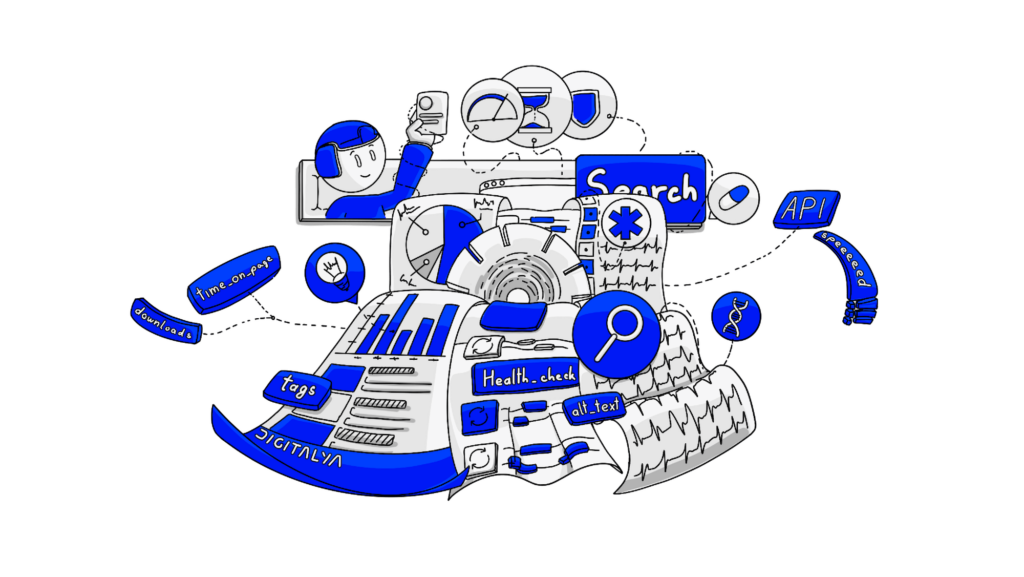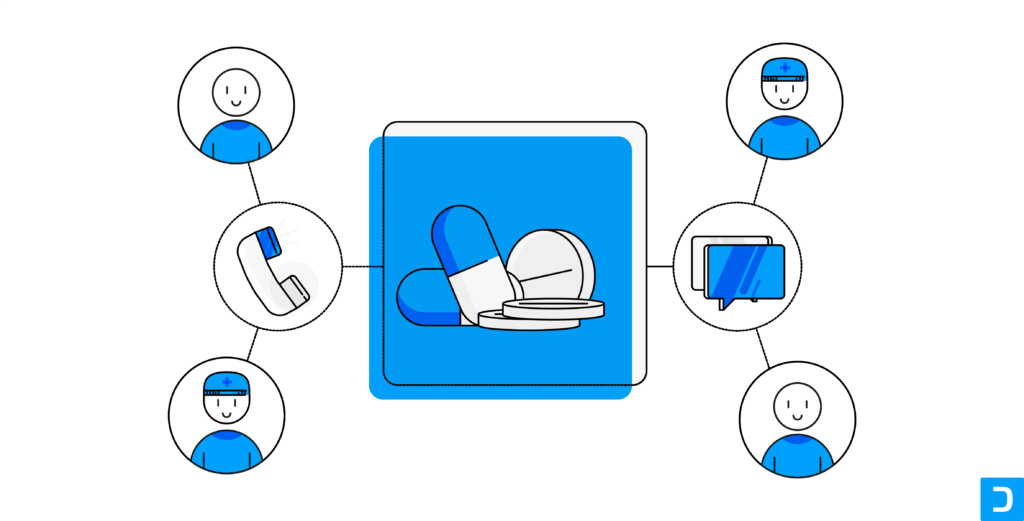Healthcare professionals and patients want a higher degree of personalized care. Technology is now at a place where it can offer the means to do it effectively.
The issue is no longer about gathering or storing data but about how to do that without jeopardizing people’s privacy or risking a security flaw that exposes sensitive information.
Being able to communicate and offer care to patients at the right time and moment is heavily expected. The pandemic accelerated the move to online consultation, communication, and follow-up care.
The patients require you to be able to meet their needs wherever they are and do that safely and securely.
By using omnichannel in healthcare, you can further anticipate particular needs by bringing the value of non-digital and digital channels together. This increases the quality of care and drives up patient loyalty and satisfaction.
There are ways in which you can achieve this if you take the necessary precautions and put patients at the top of your priority.
Now we’ll explore how you can balance personalization and privacy. We’ll also analyze how a good omnichannel healthcare strategy can help you provide better care, improve health outcomes, and increase patient engagement.
1. What is omnichannel, and how does omnichannel work?
Before diving into how omnichannel systems work in healthcare, let’s start by understanding the terms used in this post.
Omnichannel is a business strategy that offers a coherent, effortless, high-quality customer experience between and within various contact channels.
It aims to create a consistent brand experience across all customer interactions — offline and via digital tools.
This way, customers can have their interactions linked together without feeling any disconnection. One example of such integration is pharmacies offering to buy online and pick up in-store.
Another example is a phone carrier with various communication channels. Most use a combination of online websites, apps, physical stores, call centers, and door-to-door agents. Integrating these contact points means you can buy a new internet service from the store, sign the paperwork online, call the support to help with installation, and receive in-person help at home.
2. What is omnichannel in healthcare?
The healthcare industry has seen the benefits of omnichannel and started implementing omnichannel strategies into their business.
Ultimately, it makes a lot of sense when you consider all possible interaction points between healthcare providers and patients: online appointments, doctor visits, medical information, virtual care, and more.
At the same time, some healthcare organizations have field agents that provide support and information and promote specific products to the medical staff.
Omnichannel in healthcare is about offering a consistent communication and engagement experience across the entire patient journey.
3. The benefits of omnichannel in healthcare
Building an omnichannel strategy has proved highly effective in multiple industries, and healthcare is one of them.
Let’s go through the three primary benefits of omnichannel in healthcare.
a. Improved patient engagement
Since all touchpoints are interconnected, patients have multiple communication channels, and everyone involved has one source of truth.
By offering channels such as email, phone, telemedicine, online portals, and mobile apps alongside physical interactions, you can create a more personalized and convenient patient experience.
This can lead to higher patient satisfaction, better adherence to treatment plans, and in the end, better patient outcomes.
On top of this, patients can finally interact with your organization in a way that is convenient, personalized, and adapted to their preferences and needs.
The flexibility can make patients more likely to seek help faster and sooner. Those with access to virtual care options may seek treatment early instead of delaying or avoiding care due to logistical or practical barriers.
b. Better coordination of care
The value of omnichannel for healthcare goes both ways since you can’t have patient care without healthcare professionals.
By using omnichannel in healthcare, you can easily share patient data and communicate with other healthcare organizations. This leads to efficient collaborations and improved care delivery.
This is particularly helpful when dealing with complex cases where multiple specialists are involved in the patient’s care. Real-time patient data can be readily available, and once hard-to-reach professionals are now a click away from helping improve the outcome and making collaborative, informed decisions.
c. Increased efficiency in healthcare delivery
Finally, a healthcare omnichannel strategy can increase efficiency in healthcare delivery. By providing more convenient and flexible options for patient care, such as telemedicine and patient portals, and integrating them, you can reduce in-person visits and lower care costs.
On top of this, by leveraging technology to achieve intelligent automation of routine tasks and streamline processes, you can free up staff time and resources. This allows you to focus on delivering high-quality, patient-centered care across all your business units.
Another area with a positive impact is the administrative burden and workflow processes. For example, you can use digital channels to automate communication, appointment scheduling, reminders, and follow-up care.
Through this digital transformation, you are offering an improved patient experience, allowing them to use the channels that are more accessible.
Since many will choose communication and contact channels that don’t need real-time human-to-human interaction (e.g., social media or website appointment scheduling chatbots, website forms, patient portals, etc.), you can reduce the workload for administrative staff. They can use that time to focus on patient care.
Additionally, by offering virtual care options, you can reduce wait times and improve access to care without needing patients to travel to a physical location. Besides better digital experiences for patients, this can help reduce costs and improve patient outcomes by enabling early intervention and preventing unnecessary hospitalizations.
4. The importance and benefits of personalization in healthcare
Nobody wants information that does not fit their needs thrown their way. The same applies when interacting with your customers or patients.
To boost customer engagement and achieve your goals, you need to deliver dynamic content that matches the expectations of your audience, whatever that might be.
When visiting a healthcare provider’s website, visitors usually have a medical need or a question. Providing the appropriate content in a timely fashion helps people find what they need quickly.
This engagement model creates a trusted connection and promotes loyalty.
A second significant benefit of personalization is improving the digital experience for patients (or healthcare professionals if that’s your target through healthcare marketing activities). Since technology has advanced in the past years, people expect a health system that provides an online interaction on par with a face-to-face experience.
So, when someone uses your website to read information, download an ebook, or book an appointment, it’s essential to offer knowledge tailored to the patient journey they best fit in.
Tailored content gives you higher chances for them to convert and return in the future.
With an omnichannel approach, you can create specific triggers that surface relevant content for the user. Another way it can help is through customer journey mapping, assessing where they are in that journey, and pushing them to move to the next step.
A third benefit is that delivering individual experiences to consumers lowers the risk of losing them to your competitors. If your competition offers tailored customer experiences and you are not, then you must improve your healthcare strategy.
A fourth and last element is the cost savings you can achieve.
For example, a simple follow-up care process may lead to better outcomes. It ensures medication adherence, enables you to follow rehabilitation and physical therapy progress, monitor symptoms, and do timely follow-ups.
A failure in this system can mean a patient that returns to the healthcare facility for extra care, which drives costs up.
Understanding the patient’s progress, next steps, and potential drawbacks can result in personalized care that drives better results and higher recovery rates.
The consumer is recognized as a unique individual with a unique health record and receives relevant content and a better experience. At the same time, you get to know the consumer and adapt your offering, messaging, channels, and timing accordingly.
5. The importance of privacy in healthcare
Privacy in healthcare guarantees the confidentiality and security of patients’ sensitive and personal information.
Patients willingly share health information with healthcare organizations, providers, and professionals, trusting that it will be used to provide proper care and treatment.
Patients may hesitate to share sensitive information without proper privacy protections and security measures, which can negatively impact their health outcomes.
In addition to building trust, privacy is crucial in maintaining ethical standards in healthcare delivery.
Health information often contains intimate details about an individual’s life, and protecting it means respecting their autonomy and dignity.
Patients are entitled to control their personal information and determine who can access it, why, and for how long.
Disclosure of personal health information to an employer, family member, or insurer can result in embarrassment, stigma, or worse, harassment. Having a tight grip on the data and securing it is the only way to avoid these scenarios and keep your customer’s trust and confidence.
Furthermore, privacy plays a key role in ensuring that patients do not face discrimination due to their health information. Discrimination can lead to stigmatization and exclusion, harming an individual’s mental and physical well-being.
Privacy can play a more significant role in society as well.
If you want to conduct health research, you’ll have a higher chance of people trusting you if you have a good track record of high privacy and security standards.
Privacy is a fundamental aspect of healthcare that safeguards the patients’ personal and sensitive information, keeping it confidential and secure. It promotes trust, ethical standards, and patient autonomy and prevents discrimination. You must prioritize privacy to maintain trust, conduct research, and deliver high-quality care.
6. The challenges of personalization in healthcare
Achieving a high level of personalization is only possible by having vast and correct information. The data will allow you to improve patient experiences, deliver a higher quality of care, and reduce avoidable healthcare costs.
Since delivering an omnichannel experience requires operating with sensitive and personal health information, it’s vital to put a strong emphasis on:
- How you gather, store, and manage the data;
- How you can assure its privacy and data security;
- Complying with government regulations.
Let’s take a look at each element.
a. Patient data management
Patient data management is the process of collecting, storing, and using patient data to inform medical decisions.
Health data management is how you make sense of the data sets you gathered so that healthcare organizations, professionals, and patients can access and use it.
The main challenges in managing patient data are:
- Having complete data;
- Keeping the data up-to-date;
- Ensuring the data is accurate;
- Making the data easily accessible for healthcare providers to make informed decisions.
Since patient data is often scattered and collected across different systems and locations and may need to be standardized for compatibility, it is a complex challenge to have electronic health records (EHRs) readily available.
With the right omnichannel transformations, you can start creating a plan to integrate the missing parts, make them work together, and capture the correct data.
b. Ensuring patient privacy
You are working with sensitive information, so you must protect patient privacy by following strict protocols and procedures.
That means a few things:
- making sure only authorized personnel can access patient data.
- ensuring the data is only accessed for intended purposes (e.g., research, medical checks, etc.).
- having the data available for the patient.
- implementing robust security measures to protect against data breaches.
- complying with data privacy regulations.
As we can tell, a big challenge emerges: balancing the need to share data with the need to protect patient privacy. We’ll go into that topic in more detail a bit later.
c. Meeting regulatory compliance
Healthcare providers, organizations, and professionals must comply with various regulations and guidelines. These are HIPAA (The Health Insurance Portability and Accountability Act) in the US and GDPR in the European Union.
These govern how patient data is collected, stored, and used, stating the user rights over their data and the requirements for healthcare providers and professionals.
Meeting regulatory compliance implies maintaining accurate and complete patient data records, implementing appropriate security measures to protect them, and providing access to patient data upon request.
7. How to balance personalization and privacy in omnichannel healthcare
Personalized care delivery is becoming increasingly demanded. This means people expect you to be able to meet their needs at the right time and place.
At the same time, the attention towards data safety and privacy is at an all-time high everywhere, not just in healthcare. As a result, people have become more aware of how their data is collected and used and expect organizations to be transparent and keep their data secure.
This demand can influence a healthcare organization’s future if it doesn’t keep its promises of safeguarding its digital front door. Not to mention that you also have to meet regulatory obligations set by authorities.
Technological breakthroughs are here to help, as machine learning and artificial intelligence can help make sense of large data sets (for example, through analytics engines) and provide the best strategies for offering tailored care and engagement strategies to individual patients.
Therefore, if you want to find a balance between personalization and privacy, you need to:
a. Follow best practices for data management
When collecting and processing ePHI or PHI (personal health information), you must mitigate the risk of a data breach, human error, or information leaking.
Data handling
The first things to consider are the data security, the types of PHI collected, and the backup storage you use. You must focus on having maximum recovery capability in case something goes wrong. You can’t afford to lose your patients’ or professionals’ sensitive healthcare data.
Data encryption
The next thing on your list is data encryption for patient data that is in rest (inactive data stored in a hard drive, server, or other devices) or in transit (data that is forwarded or moved from one device or server to another).
HIPAA and GDPR do not specify what you must do to meet encryption compliance. Instead, they highlight that you should take “appropriate technical and organizational measures” to meet security demands.
Although it may seem vague, this helps since it enables you to use the best encryption technology available and even make advancements in the field.
Agreements with third-parties
A third necessary practice for data management is signing a Business Associate Agreement. This is used to specify the responsibilities of all parties involved in handling ePHI or PHI.
Other third parties are needed to store, access, improve, and update the systems that handle healthcare data, so you must determine their responsibilities. This agreement must also:
- Describe the permitted and required PHI uses by the subcontractors.
- Provide that the subcontractors will not use or disclose PHI other than permitted or required by law or contract.
- Require the subcontractors to use appropriate safeguards to prevent potential misuse or disclosure of PHI.
Other best practices include:
- Keeping audit and change logs — to ensure data access and changes are stored and potentially uncover wrongdoings.
- Holding regular security reviews — all parties involved must be subject to checks and education regarding HIPAA or GDPR changes to ensure compliance.
Once these basics are in place, you can start figuring out how to share that information in a personalized and secure way.
A great first step is to:
b. Implement secure communication channels
The purpose of implementing secure communication channels in healthcare is to ensure the transmitted data remains confidential and secure. This prevents unauthorized access and data breaches and maintains patient privacy and confidentiality.
Since technology has long been present in healthcare delivery, there are many ways to communicate with patients and healthcare professionals.
The issue is that as technology advances, so are the ways bad actors steal or manipulate data. These diverse methods of communication can pose a significant risk to patient privacy if not adequately secured.
Secure communication channels such as encrypted email, secure messaging, and virtual private networks (VPNs) can help reduce these risks and ensure that patient information remains private and secure.
Secure communication channels can facilitate personalized care by allowing faster and more convenient communication between patients and healthcare professionals.
For example, a secure messaging system allows patients to communicate about their symptoms, medications, and treatment without needing a face-to-face visit.
This can lead to more personalized care and better health outcomes.
Patient information can be kept confidential and secure by having secure communication channels and combining them with other methods, such as data encryption and other security measures.
This is particularly important for sensitive health information that patients may not want to share with others.
At the same time, controlling how and when your staff has access to healthcare data can add a higher degree of security while also allowing them to offer personalized care. For example, you can:
- Limit access to devices outside the work environment.
- Prevent personal devices from being used for health-related data communication or interpretation.
- Implement modern authentication (e.g., multi-factor) requirements for all systems.
- Restrict access to specific data based on who accesses the information.
- Hire professional IT staff to manage the entire process.
In conclusion, implementing secure communication channels as part of your digital transformation efforts is crucial for ensuring patient privacy and confidentiality.
c. Provide transparency and control to patients
Now you need to consider giving patients the power to control that data.
This comes with an extra layer of complexity, but it’s necessary if you want people to trust you with their sensitive health information.
Therefore, patients have the right to know how their health information is used and shared. On top of this, they should have the means to decide and control who can access their healthcare information.
A big step toward achieving transparency is offering patients clear and easily understandable information on how their health information is collected, used, and shared.
You can do this through privacy policies, consent forms, or other communication methods.
These tools help patients make informed decisions about their healthcare and allow them to feel confident that their data and privacy are protected.
Besides transparency, patients need to have control over their personal health information. You can achieve it by creating patient portals. These allow patients to access their health information and control who can see and use it.
Lastly, patients can have the option to opt out of specific data-sharing programs or restrict access to certain information.
Transparency and control will ultimately help you offer personalized care that leads to better patient outcomes while ensuring privacy.
Patients are more open to engaging with healthcare providers and sharing their PHI when their privacy is respected and they can control access to their health information.
d. Use technology to balance personalization and privacy
You now have the means to collect and store healthcare information and privately communicate with patients, and can offer tools to manage their data.
The next step is to leverage technology through omnichannel software development to deliver personalized care and communication at the right time and place and to the right people.
With all these pieces together, you can address the customer frustrations regarding the slow and fragmented nature of the traditional healthcare system.
You can go further and use machine learning and artificial intelligence to intervene at the right moment while protecting the patient’s privacy.
Combining traditional medical and clinical data with social and behavioral health factors allows you to take patient care to the next level. You can suggest specific tests or identify when they need a consultation.
Although technology allows you to gather information about many touchpoints, finding a balance between the data and the need for a personalized experience is important.
You might not need information about the patient’s physical location to provide customized content. In turn, your focus might be on what patients are looking for on your platforms or the data they willingly share. You can use that for an effective journey mapping process.
Use technology to your advantage and avoid alienating people by gathering irrelevant information.
8. Conclusion and key points to remember
Through omnichannel engagement strategies, you can deliver personalized experiences and care to patients and other healthcare professionals. But to achieve that, you must ensure that the data you collect follows government guidelines and is kept safe, secure, and encrypted.
By putting the proper data management practices in place, you can start thinking about how to communicate best and reach patients and professionals in a timely and customized manner.
Once you have secure communication channels, you can start exploring how to leverage and bring together all those channels to offer an authentic omnichannel experience. You can expand that to your marketing efforts and get more people through your digital front door.
The answer can be building omnichannel software that ties various elements together and takes your healthcare delivery efforts to the next level.










